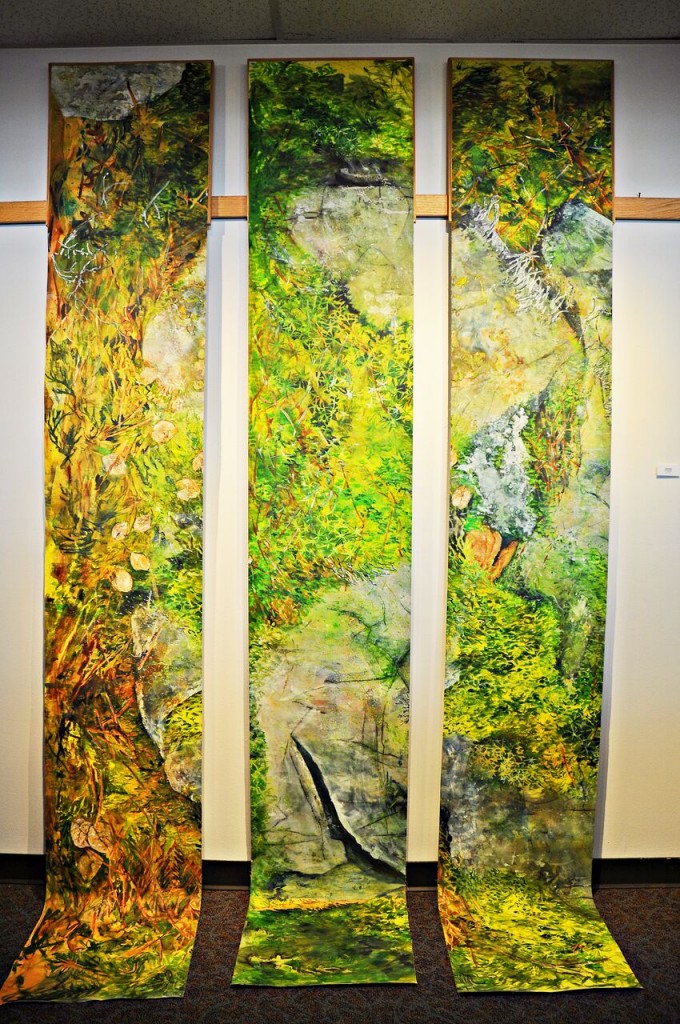
‘Land: An Imagining’ showcases immerses works of Claire Moore
By Caroline Ho, Arts Editor
It’s easy to imagine yourself lost among the diversity of nature in the Amelia Douglas Gallery’s new exhibition Land: An Imagining.
The exhibition, which opened last Thursday, features the enrapturing paintings and shadow boxes of Claire Moore. All of the pieces, as the show’s title suggests, explore our relationships to land and to other species of life, challenging us to reconsider how we conceptualize our planet and our role among countless interconnected ecosystems.
Moore told the Other Press at the gallery’s opening reception that she likes to think of the land not just in material terms, but on a more conceptual level. She said she prefers “viewing the land not as a resource, but almost like an imaginary space that we connect to in some way.”
Unusually for the Amelia Douglas Gallery, Land: An Imagining has just four paintings—but each of the pieces is strikingly large, more than filling the walls with size and intricacy. The biggest, “Submerged Nursery,” is 228” by 61”. Moore said she doesn’t always create such large paintings, but she does find it liberating to work on expansive canvases.
Her artwork is largely inspired by the forest ecosystems of the West Coast, where she has lived for about 25 years. However, her pieces are often not based on specific locations, but rather driven by ideas and concepts that come together and inform her choice of materials, subjects, and stylistic depiction.
On the intricate “Lost Narrative,” for example, which shows layers upon layers of plant life against rock, she explained that the idea for the piece came about when she was walking through a rainforest and noting how each step she took sank into the earth. This in turn prompted her to consider both the physical and abstract impacts of human presence.
“It was a very conscious awareness of leaving a footprint behind, and so that footprint idea led to a sort of metaphorical footprint of how do we leave our traces on the land?” she said.
Moore also drew inspiration for this piece from seeing a digital exhibit in a new media gallery, and wanting to create a more traditionally immersive experience.
The title of “Lost Narrative” evokes the idea of uncovering the stories and connections people have to the land, a theme of interconnectedness that threads through all the works in Land: An Imagining. “Hidden Lives,” another painting, depicts a beautifully dense network of roots, showing the complexity of mycorrhizal systems—symbiotic relationships of roots and fungi that transmit nutrients and information beneath the earth. However, Moore says the piece can also be interpreted as neurons, as space, or as whatever else a viewer sees in the interconnected lines of activity.
In addition to the paintings, Land: An Imagining also features three of Moore’s shadow boxes. The walls of the boxes consist of charcoal drawings of blackberry bush roots on parchment, while inside the boxes are rotating turbines with light boxes. The turbines are adorned with moss and lichen, and as they slowly spin they cast shadows of their forms against the translucent parchment walls.
Mosses and lichens, said Moore, are indicator species in forests, meaning they “reflect the health, or lack of health, of a forest from the beginning.” The shadow boxes show this idea of underlying conditions, a reminder that we have to look through the outer layers to see the health of the ecosystem beneath.
Land: An Imagining will be in the Amelia Douglas Gallery, on the fourth floor of the New Westminster campus, until December 16.



